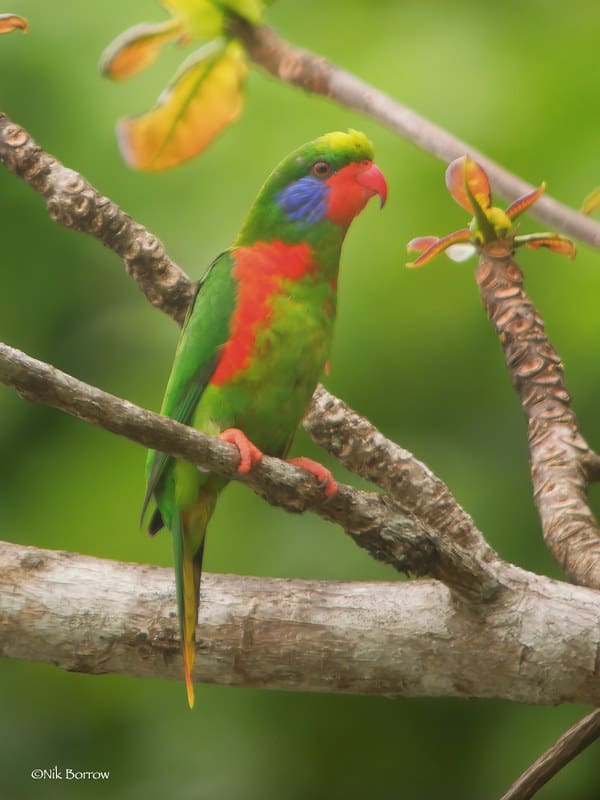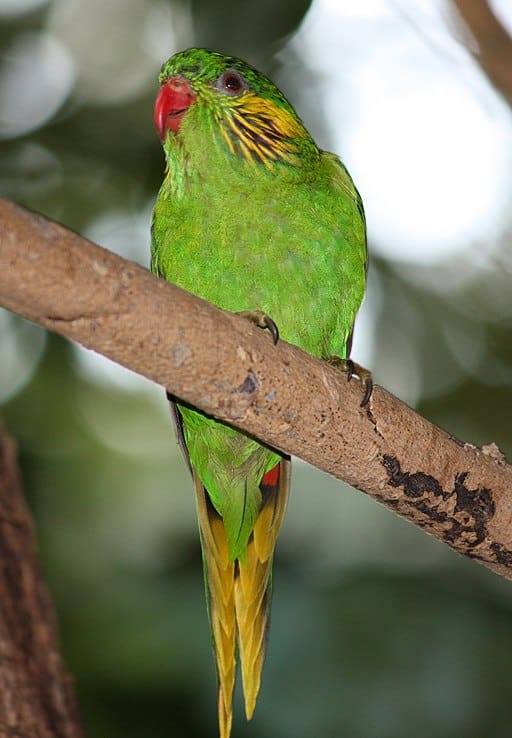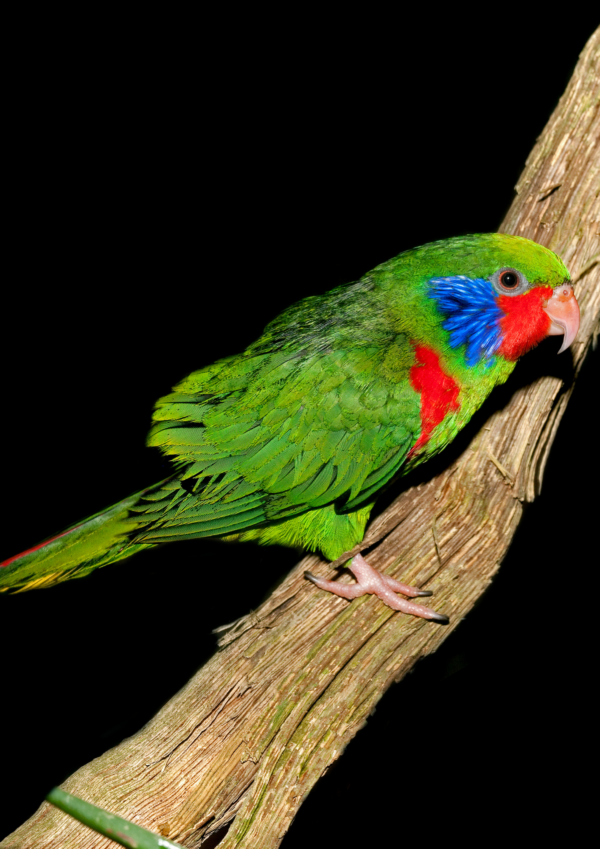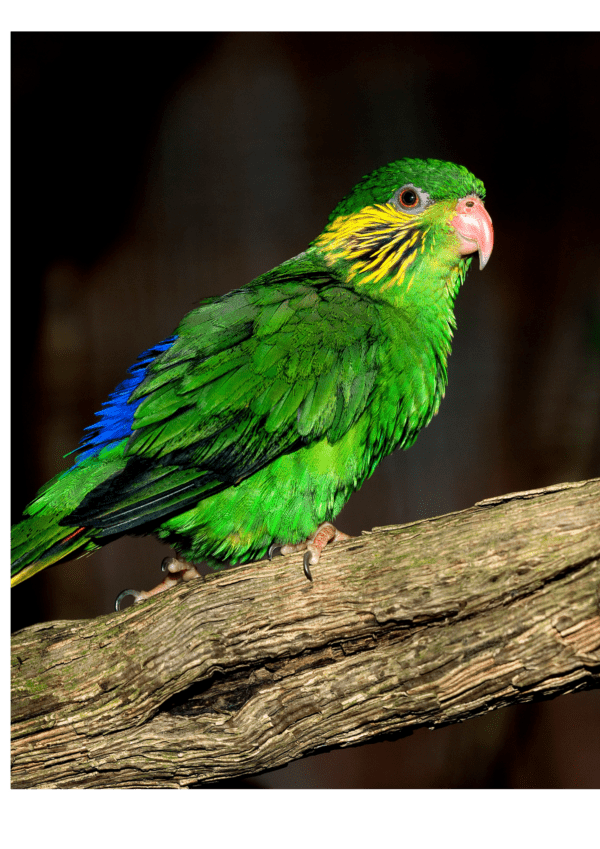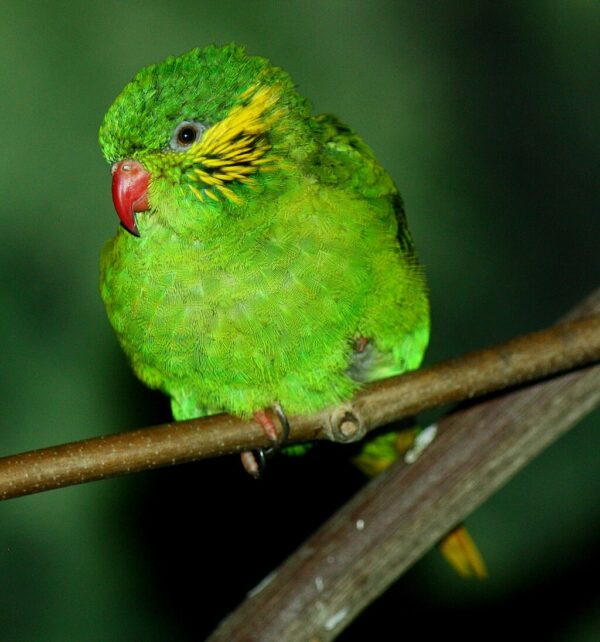Red-flanked Lorikeet
Also known as:
Blue-eared Lorikeet, Pleasing Lorikeet
Also known as:
Blue-eared Lorikeet, Pleasing Lorikeet
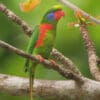
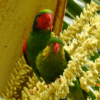
![© Ltshears [CC BY-SA 3.0 or GFDL] via Wikimedia Commons](https://parrots.org/wp-content/uploads/2023/01/wpt_Red-flanked-Lorikeet_1253-4-100x100.jpg)


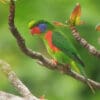
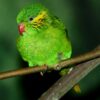
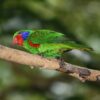
DID YOU KNOW?
The Red-flanked Lorikeet has been observed investigating arboreal termitaria (termite nests in trees), likely in preparation for nesting.

Charmosyna

placentis
Size:
17 cm (6.6 in)
Weight:
38-48 g (1.3-1.7 oz)
Subspecies including nominate:
five: C.p. placentis, C.p. intensior, C.p. ornata, C.p. subplacens, C.p. pallidior
Colour Adult:
C.p. placentis: Male-green/yellow forecrown; rump has dark blue patch; dull red lores, cheeks and upper throat; purple/blue ear coverts with pale blue streaking; red underwing coverts to sides of breast and reaching to flanks; yellow band under the wings; green tail tipped with yellow, the centre tail feathers red toward tips; lateral tail feathers have red at base. Beak red. Eye yellow. Female-darker green forecrown; red markings instead green; dull blue/black ear coverts with strong yellow streaks; rump has dark blue patch.
C.p. intensior: Both adults blue patch on rump smaller.
C.p. ornata: Both adults blue patch on rump larger; male the red of upper throat extends to lower.
C.p. subplacens: Both adults as in placentis, but blue on rump absent.
C.p. pallidior: Both adults as in subplacens, but in general plumage paler, especially the blue ear coverts of the male.
Colour Juvenile:
C.p. placentis: As in adult female but males have some red on lores and green/yellow on forecrown. Beak brown. Eye yellow/brown.
Call:
Calls are described as shrill and high-pitched staccato notes. Also described as harsh.
More Information:
Content Sources:
CITES
BirdLife International
Cornell Lab of Ornithology/Birds of the World
Parrots: A Guide to Parrots of the World, Juniper and Parr, 1998
Parrots of the World, Forshaw and Cooper, 1977. 2010 edition
Parrots of the World, Forshaw, 2006.
Lexicon of Parrots, Thomas Arndt.
Parrots in Aviculture, Low, 1992.
Parrots: Their Care and Breeding, Low, 1986.
Captive Status:
Rare in captivity.
Longevity:
—
Housing:
Aviary with well-drained concrete floor, or indoor enclosure 1.2 m (4 ft) long in tiled room and floor.
Diet:
Commercial or homemade type nectar made from a mixture of lactose-free baby cereal, honey, malt extract or molasses and mixed with filtered water, made fresh once or twice daily; fruits such as: apple, pear, banana, oranges, cactus fruits; soaked figs and sultanas; spray millet if taken.
Enrichment:
Vigorous chewer so provide bird-safe, unsprayed flowering, fir, willow or pine branches, heat-sterlized pine cones, wooden block toys (changed frequently), foraging and puzzle toys. Also enjoys bathing so provide overhead misters or shallow bowls of water.
Nest Box Size:
Vertical box 7″ x 7″ x 14″ (17.8 cm x 17.8 cm x 35.5 cm).
Clutch Size:
2
Fledging Age:
7 weeks
Hatch Weight:
—
Peak Weight:
—
Weaning Weight:
—
World Population:
Unknown; reported as generally common. Decreasing.
IUCN Red List Status:
Least Concern
CITES Listing:
Appendix II
Threat Summary:
This species is considered to have a medium dependency on forest habitat, and tree cover in its range is estimated to have declined by 2.5% over the past 10 years. Therefore, it is tentatively suspected that this may have led to a 1-19% decline in the species’ population over the same time frame.
Range:
C.p. placentis: S Moluccas through Kai and Aru Islands, Indonesia, to S New Guinea.
C.p. intensior: N Moluccas and Gebe, in W Papuan Islands, West Papua.
C.p. ornata: W Papuan Islands except for Gebe and nearby NW New Guinea.
C.p. subplacens: E New Guinea.
C.p. pallidior: Woodlark Island and Bismarck Archipelago to Nuguria and Nissan Islands, Buka and Bougainville, and Lou and Pak in eastern Admiralty Islands, E Papua New Guinea.
Habitat:
Found up to 1400 m (4592 ft) in humid primary forest, forest edge, savanna, tall secondary growth, monsoon forest, sago swamps, gallery forest, eucalyptus, coastal forest and mangrove. and coconut groves.
Wild Diet:
Feeds on pollen and nectar of Erythrina indica, Schefflera, Syzygium, Melicope, Poikilospermum, Dimorphanthera and Cocos nucifera. One observation of birds seen feeding on lichen and moss off trunks, branches and epiphytes.
Ecology and Behaviour:
Seen in pairs and occasionally groups of 25 or more. Groups of birds forage in flowering trees and epiphytes. Can be quiet and unobtrusive and difficult to see in foliage, however, noisy and active while feeding.
Clutch and Egg Size:
2 rounded eggs, 19.0 x 17.5 mm (0.7 x 0.65 in).
Breeding Season:
February-November. Nests are in arboreal termitaria or occasionally staghorn fern or moss clump.
Related Links:
—
